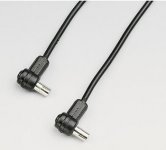I haven't found much info on how to hook up a flash/what's compatible. I'm guessing it's kind of useless because of the slow, 1/55th sync speed. but I'm curious to know if anyone out there utilizes it somehow.
I do use flash -- including studio flashes -- on my P occasionally. Fjäll is right, all you need is a cable with a standard PC sync plug on one end (to plug into the camera's PC sync jack) and whatever type of connector your flash uses on the other end. If the flash also has a hot shoe, you may need to put a piece of tape in the camera shoe to keep it from shorting the flash contacts and making the flash go off spontaneously.
Another option if you have a hot-shoe flash is to buy a PC-to-hot-shoe adapter, which sits in your camera's "cold" shoe and has a hot shoe on top plus a short cable that plugs into the camera's PC connector. Then you just slip whatever kind of hot-shoe flash you want to use into the hot shoe on top of the adapter. It really spoils the clean appearance of your P, but it works.
Of course there's no TTL flash exposure, so you have to find a flash that has a "sensor eye" for automation (you set the camera to a specified f/stop and then the sensor eye controls the output of the flash to yield correct exposure over a range of distances.) Or, use a manual flash and the old-fashioned guide number method: look up the guide number for the flash at the ISO speed of the film you want to use (let's pick a guide number of 56 at ISO 100 as an example), then focus the camera on your subject, note the distance on the lens, then divide that distance into the guide number to get the f/stop you should use. In the case of our example, let's say your subject is 10 feet away; 56/10 = 5.6, so you'd set your lens to f/5.6. Warning: Sometimes guide numbers are stated in meters, so if that's the case use the subject distance in meters instead of feet.
If I'm going to go to the bother of using flash, though, I usually am going to want to use fancy flash -- two or three lights, modifiers, etc. I use Godox studio flashes with built-in radio power control, so all I need on the camera is a wireless transmitter to set power levels and fire the flashes. For my P and other "classic-era" cameras, I like to use this
Flashpoint R2 single-pin transceiver, which is much more svelte than the big Godox TTL triggers, so it doesn't block access to the shutter speed dial the way they do. The transceiver connects to the camera's flash sync port via a PC-to-3.5mm cable. It makes a very handy setup on the P. Again, with no TTL flash metering, you're on your own for setting exposures, and if you're using several flashes the easiest way to do this is with a hand-held meter with flash metering capability.
If anybody is going to ask what's the point of using a Canon P with studio flashes, I will tell you why: because it's effin' awesome. The huge advantage of any rangefinder camera with studio flash is that you can watch your subject continuously through the viewfinder and actually SEE the flashes go off, something you can't do with any SLR. If you're trying to catch your subject's actions or facial expressions, being able to see the flashes helps you feel much more connected. Yes, even though the flashes are very brief, with practice you can learn to see whether you got the action/expression you wanted or not. And with the P (or with a Canon VI or a Voigtlander Bessa R3, all of which have 1:1 viewfinders) you can do that while keeping both eyes open, which is pretty much the ultimate in viewing comfort.
Finally about that 1/55 sec. X-sync speed: Yes, it's a bit limiting, but it's certainly not useless. If you're using flash in a dimly-lit scene or a studio setting, the flash usually will overpower the ambient light and 1/55 is fine. If you're trying to blend flash with ambient light, it makes your job a bit harder because 1/55 is the fastest you can go. BUT... even the fanciest modern cameras usually have flash sync up to only 1/250, and that's only 2 stops faster than what you get on the P, so it's not a case of impossible vs. possible but of slightly harder vs. slightly easier. If you're really into mixing ambient light and flash, you're probably going to have to juggle neutral-density filters a bit regardless, so you're not really incurring much of a disadvantage if you want to shoot with your P.
So, is that 'way more than everybody wants to know about using flash on a Canon P? You're welcome!



